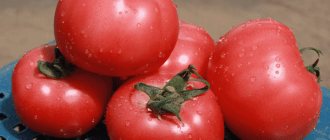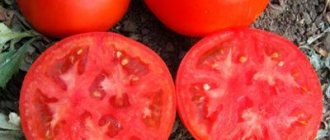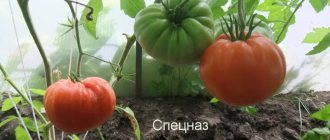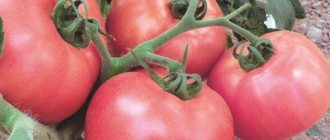Growing tomatoes is not only healthy and tasty, but also fun and exciting. Especially with a find like the Purple Pumpkin. Huge corrugated fruits look luxurious. You can use them to prepare royal salads and create a lot of delicacies for winter.
| Height | Landing location | Ripening time | Fruit color | Fruit size | Origin | Fruit shape |
| Tall | Greenhouse, Open ground | Mid-season | Bicolor | Large | Variety | Flat-round |
Description of the tomato variety Purple Pumpkin, reviews, photos
The original name of the tomato is Purple Calabash .
Mid-season, tall, indeterminate tomato variety. Recommended for growing in greenhouses (in the middle zone) and in open ground in the southern regions with mandatory tying to a support. It is best to form a plant into 2-3 stems. The height of the bush is up to 1.7 meters.
Fruit characteristics
photo author A. Kulik
The fruits are large, flat-round, ribbed, purple in color (closer to purple) at maturity, weighing up to 300 grams. The fruit pulp is juicy, tasty, with a slight sweetness.
The variety is very productive and beautiful.
In some catalogs this variety is found under the name Purple pumpkin , Pink calabash .
Features of cultivation of Purple pumpkin
Purple pumpkin tomatoes are successfully cultivated in many regions of the Russian Federation, Moldova and Ukraine, but they are most successful when grown in the middle zone and in areas with a fairly warm climate.
It is most preferable to cultivate them in open ground, since the richness of the color and the content of the plant glycoside anthocyanide in tomatoes, which has a healing effect on the human body, depend on bright sunlight. This element strengthens blood vessels and reduces capillary fragility.
Purple pumpkin is a variety that, when its seeds are harvested, imparts all the parental characteristics to its offspring. Therefore, you can collect the grains of this tomato yourself, planting this tomato wonder on your plots for more than one season. Seeds are selected from ripened fruits, washed thoroughly under running water and dried.
Before sowing tomatoes, which falls in the second or third ten days of March, containers with soil are brought into a warm room. It is advisable to purchase soil mixture for seedlings in specialized stores. Before planting, seeds must be disinfected and stimulated. To do this, the seeds are soaked for 30-40 minutes in a weak solution of potassium manganese at the rate of 0.01 g per 1000 ml. Then the seeds are washed under running water and immersed in any growth stimulator for 10-12 hours. After drying, the grains are ready for planting. The soil in the containers must be moistened, the seeds must be spread at a distance of 1.5 cm by 1.5 cm, buried by the same amount and covered with soil.
Containers with sown tomato seeds are covered with newspaper or polyethylene and placed in a dark, warm place. In a few days, the first seedling loops will begin to peck. After they appear, the covering material is removed, the temperature in the room drops by several degrees, and the containers with seedlings are placed in the most illuminated place. After the tomato seedlings grow 2-3 true pairs of leaves, the young plants dive into separate pots, trying to bury each one as much as possible into the soil, in no case covering the root collar during this action.
When positive night temperatures are established in the second or third decade of May, the seedlings are planted in open ground, having previously been hardened for 7-10 days. In order for the fruits of the Purple Pumpkin to acquire a rich, bright color during the growing season, the soil must be prepared in advance before planting the seedlings by adding to each hole:
- 25 g superphosphate;
- 30 g potassium;
- 20 g nitroammophoska;
- humus;
- 1 glass of ash.
During the entire tomato growing season, it is necessary to carry out all appropriate agricultural practices, which include: tying to trellises, forming a bush with one or two stems, pinching, watering with warm water, fluffing and fertilizing. Fertilizers for tomatoes must be applied 3 times per season, using a special complex fertilizer during the periods:
- complete survival of seedlings;
- formation of flower brushes;
- pouring fruit.
Features of cultivation
Sowing the seeds of this variety of tomatoes for seedlings is carried out 60-65 days before the intended planting in the ground.
If you have grown Purple Pumpkin tomatoes, please write whether you liked them or not. What was the yield and taste of the fruits like under your climatic conditions? Write briefly the advantages and disadvantages of this tomato in your opinion. If possible, attach a photo of the entire bush or individual fruits you grew to your comment. Thank you!
Your reviews of the Purple Pumpkin tomato and additions to the description will help many gardeners evaluate this variety objectively and decide whether it is worth planting or not.
Growing tomatoes is not only healthy and tasty, but also fun and exciting. Especially with a find like the Purple Pumpkin. Huge corrugated fruits look luxurious. You can use them to prepare royal salads and create a lot of delicacies for winter.
Reviews and uses of tomato Purple pumpkin
After growing this variety on their plots, many gardeners complain that their tomatoes never turned purple, but only acquired a pinkish-purple hue. This is explained by the fact that when cultivating tomatoes, agrotechnical techniques were not followed, and the soil was not sufficiently fertilized. In addition to this unpleasant fact, many gardeners were very pleased with the Purple Pumpkin due to its resistance to pathogens, taste and decorative properties.
Purple pumpkin is not at all suitable for canning in its entirety at home, but it produces good juice, paste and sauces, distinguished by an original shade and a pleasant fruity-tomato taste.
Description and characteristics of the variety
The Purple Pumpkin tomato is included in the tall growing indeterminates. Strong and powerful bushes have characteristic features:
- stem height 1.8-2 m;
- semi-spreading branched trunks;
- 3-5 tomatoes in clusters;
- inflorescences are simple.
What is a typical tomato variety description:
- average weight 250-350 g;
- giant fruits weigh up to 500-600 g;
- purple color with purple tints;
- pronounced ribbing at the stalk and on the sides - the fruit resembles a flower;
- the flesh is fleshy, tender, moderately juicy;
- The taste has sweetish notes, there is a fruity aftertaste.
Tomato Purple Pumpkin Purple Calabash Growing and Care
Sowing seedlings
We recommend sowing seeds for seedlings 65-70 days before the intended planting in the ground.
To sow Purple Pumpkin tomatoes, you must use special containers: plastic containers, seedling cassettes, and so on. Any containers must have special drainage holes at the bottom, otherwise the plants will be susceptible to blackleg disease. Before starting sowing, it is necessary to ensure good lighting, regular temperature and air ventilation.
To sow tomato seedlings, you can use any universal substrate or a mixture of sand and peat, taken in equal parts. You should not sow too thickly, otherwise the seedlings will stretch out and be thin and weak. In a greenhouse, sowing should be done in rows, this will allow the lighting to be used to maximum advantage.
Immediately before sowing, the substrate must be thoroughly moistened. You can sow dry or pre-soaked in a 1% solution of potassium permanganate. Place the seeds in a glass with the solution and leave for about half an hour. After this, the seeds must be washed in running water. Immediately after sowing, the substrate must be covered with film or a thin (about 5 mm) layer of vermiculite, this will help maintain soil moisture.
Until the first shoots, you need to maintain a temperature of about +28°C. And immediately after their appearance, the film must be removed from the seedling containers. In order not to expose the still very weak seedlings to excessive evaporation, it is better to remove the film in the afternoon. Watering should be done with a finely sprayed stream; the seedlings should not be overly flooded with water. It is also necessary to observe the temperature regime: as soon as the first shoots appear, the temperature should be reduced to +8...+10 °C at night and +10...+15 during the day - within 3 days, thus hardening the seedlings from the first days of their growth. Hardening must be continued until it is transplanted into the greenhouse, but for no less than 15 days during the entire period of its growth.
When the seedlings get a little stronger, the temperature is again raised to 20-25 degrees. The recommended air humidity for growing seedlings is 60-70%.
At two weeks of age, the seedlings are planted in separate cups.
Planting in the Ground In order for tomatoes to produce a good harvest and not get sick, it is necessary to observe crop rotation. The best predecessors for them will be root vegetables (excluding potatoes), all types of cabbage, and perennial herbs.
The soil should be neutral or slightly acidic. Light and fertile soil contributes to earlier harvesting.
Tomatoes are planted in open ground after the threat of frost has disappeared; the seedlings must first be hardened.
At first, it is recommended to cover the plants with film or agricultural material to protect them from the cold.
Drop off rules:
Most often, tomatoes are planted in two rows with an interval between plants of 25-30 cm. Row spacing should be 50-65 cm wide. Overgrown seedlings are planted obliquely, with their tops facing north. After planting, make sure that a hard crust does not form; the soil is regularly loosened after watering.
15-20 days after planting, the tomatoes need to be hilled; in the future, this procedure is carried out twice more. Simultaneously with hilling, mineral fertilizers are applied. Their deficiency can be identified by the appearance of the plants.
Tomatoes do not like irrigation by sprinkling; moisture is applied strictly at the root. The culture requires rare but abundant watering. You can determine the need for moisture by the appearance of the tomatoes - the leaves darken and become drooping.
For the first 10-15 days after planting the seedlings, tomatoes do not need to be watered; the moisture added during planting will be enough for them. With the appearance of ovaries, the need for water in tomatoes increases sharply. At this time, the plants are watered at intervals of 5-7 days, adding up to 10 liters of water under each bush.
To retain moisture in the soil during the fruiting period, mulching is used. When the tomatoes begin to yield, watering is reduced.
Tomatoes can be formed into one, two or three stems.
All stepsons are removed, not allowing them to grow more than 5 cm in length. This procedure must be performed in the morning on a sunny day so that the wounds heal before evening.
Planting and care
Sowing is carried out at a distance of 2-3 cm between seeds. The grooves are sprinkled with a finely dispersed compound on top.
What conditions need to be created for seedlings:
- Temperature regime at 18-20 degrees.
- Moderate humidity 50% due to balanced irrigation.
- Lighting for 12-14 hours.
- Diving at the 2-leaf stage.
- Author: Maria Sukhorukikh
Rate this article:
- 5
- 4
- 3
- 2
- 1
(0 votes, average: 0 out of 5)
Share with your friends!
A storehouse of vitamins in one fruit - the Purple pumpkin tomato: description of the variety, reviews of yield
Growing tomatoes is not only healthy and tasty, but also fun and exciting. Especially with a find like the Purple Pumpkin. Huge corrugated fruits look luxurious. You can use them to prepare royal salads and create a lot of delicacies for winter.
| Height | Landing location | Ripening time | Fruit color | Fruit size | Origin | Fruit shape |
| Tall | Greenhouse, Open ground | Mid-season | Bicolor | Large | Variety | Flat-round |
Description of the variety
Tomatoes of the Yaki variety belong to the mid-season group. Tomatoes ripen in 113-118 days, depending on weather conditions. If the summer is cool, the ripening process will be long. Gardeners recommend ripening tomatoes at home.
If the summer is sunny and warm, then the fruits are left on the bush until fully ripe. They hold well on the stalk and do not fall off.
Determinate variety. The bush grows up to 50 cm in open ground. In a film tunnel it can rise up to 70 cm. The plant is not standard. It is arranged in 2-3 stems. The branches are tied to a peg or laid out on a bed, but it must be mulched.
The lower peduncle emerges above the 6th leaf. The next ones appear after 2 leaves. In total, up to 5-6 levels can be formed on one stem. The fruits grow in clusters. There are more than 10 berries in one bunch. They ripen at the same time if they are tied to a peg along with a branch.
During the ripening period, all leaves around the brush are removed. This way the berries will be evenly illuminated by the sun; the fruits ripen at the same time:
The hybrid variety is not whimsical, but it is recommended to improve the area for it. Compost, vermicompost, peat or sand are added to it. The soil is disinfected with ash or slaked lime, but it is used less often.
created a variety with a similar name, Yakimanka f1. This is a large-fruited, indeterminate tomato with a medium-early ripening period.
It is intended for extended circulation. The fruits weigh 180 g. Productivity is 38 kg/m2. The plant is protected from many fungal infections.
If there were plants with signs of infection on the site, then it is not recommended to use such soil. It is irrigated with Bordeaux mixture and green manure is planted on the plot.
If organic matter is added to the garden bed in the fall, then mineral fertilizers are introduced in the spring. It is recommended to use mixtures that contain a large amount of microelements: superphosphate, AMKO Harvest, Sotka Harvest, Borogum-2.











